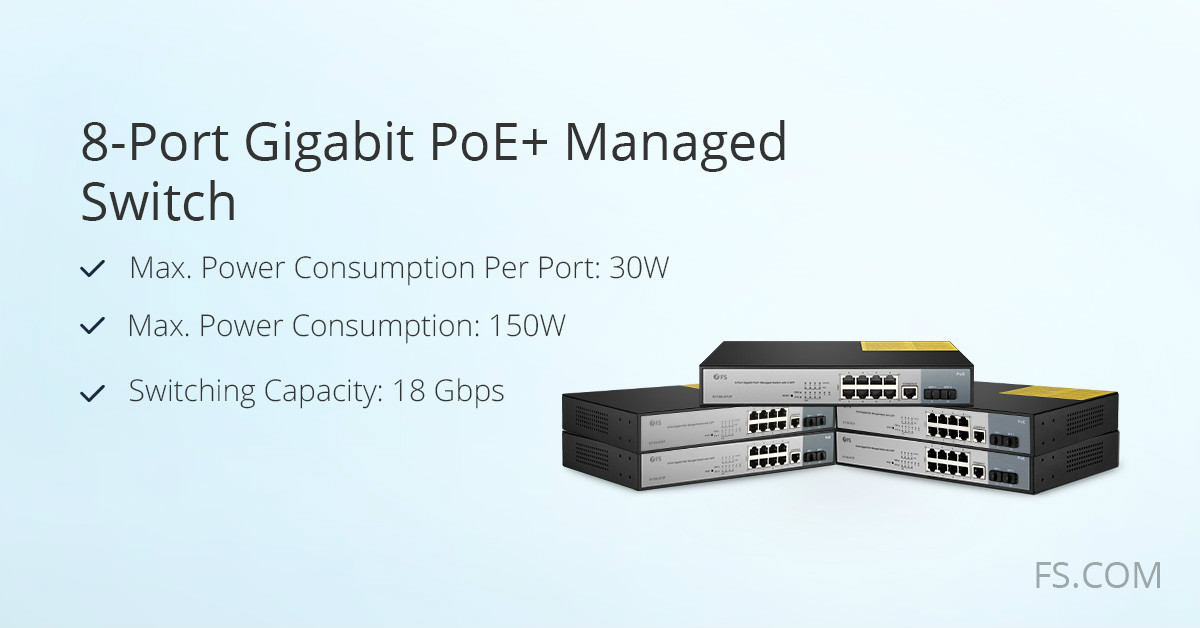There are many different network switch in the market and it comes with 8, 16, 24 or 48 ports. Among them, 8 port Gigabit switch is regarded as a cost-effective choice for small-sized families and business use. Then, how to choose an 8 port Gigabit switch? Are there any recommendations for it?
How to Choose an 8 Port Gigabit Switch?
The 8 port Gigabit switch is available in several types, including PoE or Non-PoE, managed or unmanaged, stackable or standalone. The following will tell you how to choose an 8 port switch from these types.
There is no doubt that a Gigabit PoE switch is better than the Non-PoE one. A Gigabit PoE switch is able to transmit both data and power supply over the existing Ethernet cable to network device at the same time. It can help reduce the cabling complexity and save the cost of installation and maintenance. Usually, it is used for VoIP phones, network cameras and some wireless access points. The 8 port Gigabit PoE switch is one of the most popular PoE switches for IP camera system.
Unmanaged switch, as a plug & play switch, has limited performance and doesn’t support any configuration interface or options. While managed switches can offer good protection of the data plane, control plane, and management plane. Besides, it is also able to incorporate Spanning Tree Protocol (STP) to provide path redundancy in the Ethernet network. Additionally, managed switch enables more bandwidth to be contributed through the network. This function brings higher network performance and better transmission of delay-sensitive data. For your home use, a managed 8 port Gigabit switch may be a better choice.
In the use of standalone switches, each switch is managed and configured as an individual entity. However, with the improvement of the network, you will need more switches to connect the devices. So the stackable switch has emerged. Compared to the use of multiple standalone switches, stackable switches provide simplicity, scalability, and flexibility to your network.
8 Port Gigabit Switch Recommendation
FS S1150-8T2F 8 port Gigabit PoE+ managed switch has 8x 10/100/1000Base-T RJ45 Ethernet ports, 1x console port, and 2x Gigabit SFP slots. The transmission distance of its SFP fiber port can be up to 120km, and with high resistance to electromagnetic interference. Besides, this switch complies with PoE+ standard for higher power capacity than PoE standard. It is highly flexible that controls L2-l7 data based on physical port and has powerful ACL functions to access. It also features superior performance in stability, environmental adaptability. This 8 port switch is best fit for weather-proof IP cameras with windshield wiper and heater, high-performance AP and IP telephone.

Figure 1: 8 port Gigabit switches
Conclusion
The 8 port Gigabit switch is a cost-effective and efficient solution to satisfy the demands of bandwidth-intensive networking applications. Before buying an 8 port Gigabit switch, you’d better take the quality, power requirement, price, into consideration. If you are looking for the best 8 port Gigabit switch, FS.COM would be one of your proper choices.
Related Article: Using 8 Port PoE Switch for IP Surveillance System










